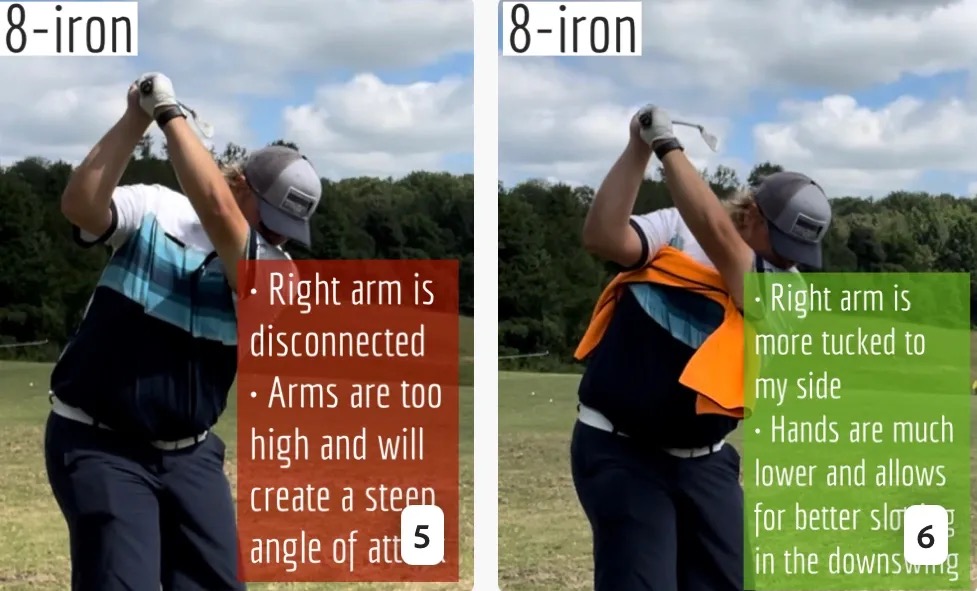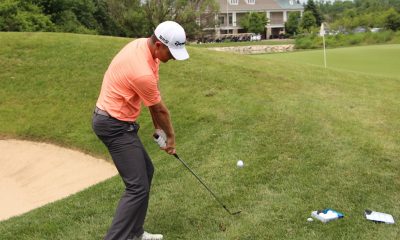Instruction
Kelley: Three ways to manage first-tee stress

1. Let your thoughts come and go
Positive thinking doesn’t always work. Ever tried to just think positive expecting everything to go as planned only to be let down when it doesn’t? Afterwards, you are left even more frustrated. Although a positive outlook is better than a negative mindset, only preparing for positive outcomes is unrealistic.
Rarely things go perfectly as planned. Golf can be chaotic at times. Research shows mentally rehearsing for both a poor outcome and a good outcome will be more beneficial. This will put your mind at ease and help you develop the tools to rebound from a not so great start. The night before, plan a reaction to how you will grind from a poor start to the round. If a negative thought pops into your mind, let it pass.
2. Actually practice being present
Everyone has heard to be “present” during stressful situations.” However, this needs to be practiced, and the concept needs to be understood. Being present entails being mindful of something in the current moment. Not just a void mind. This can be as simple as focusing on your breathing or focusing on feeling the club swing when you are on the tee box waiting your turn.
A common one I found beneficial is to simply focus on the hole ahead of you. Ask yourself the question, “What does a good shot look like here from this tee box? You can think about how the course architect designed the hole. Figure out how the hole should be properly played from the architect’s view. Even a moment of gratitude for having your health to play golf that day will work wonders.
The beauty of this is it can actually be practiced away from the golf course. Next time you are outside, see how long you can go for a walk staying present in the moment. Practice noticing the buildings around you, then when your mind drifts, gradually bring it back.
3. Understand the concept of attention
This is the holy grail. Where you place your attention during the actual golf swing can play a major factor in the outcome of the shot. “Attention” is simply what you are mindful of during the actual motion. This is massively different then a “swing thought”. There are multiple places where a player can place their attention and it is best discovered through trial and error.
A few examples of where attention can be placed is on the start line of the shot, feeling the pressure move in your feet or simply being aware of your body throughout the motion. Usually, the best places to place your attention is somewhere you can keep it throughout the swing. This helps the player stay committed to the shot. If you have an awareness you know can maintain during the entirety of the motion, you will swing more freely with confidence.
(Kelvin now offers online lessons and consultations through his website)
- LIKE17
- LEGIT6
- WOW0
- LOL1
- IDHT0
- FLOP0
- OB0
- SHANK0
Instruction
How a towel can fix your golf swing

This is a classic drill that has been used for decades. However, the world of marketed training aids has grown so much during that time that this simple practice has been virtually forgotten. Because why teach people how to play golf using everyday items when you can create and sell a product that reinforces the same thing? Nevertheless, I am here to give you helpful advice without running to the nearest Edwin Watts or adding something to your Amazon cart.
For the “scoring clubs,” having a solid connection between the arms and body during the swing, especially through impact, is paramount to creating long-lasting consistency. And keeping that connection throughout the swing helps rotate the shoulders more to generate more power to help you hit it farther. So, how does this drill work, and what will your game benefit from it? Well, let’s get into it.
Setup
You can use this for basic chip shots up to complete swings. I use this with every club in my bag, up to a 9 or 8-iron. It’s natural to create incrementally more separation between the arms and body as you progress up the set. So doing this with a high iron or a wood is not recommended.
While you set up to hit a ball, simply tuck the towel underneath both armpits. The length of the towel will determine how tight it will be across your chest but don’t make it so loose that it gets in the way of your vision. After both sides are tucked, make some focused swings, keeping both arms firmly connected to the body during the backswing and follow through. (Note: It’s normal to lose connection on your lead arm during your finishing pose.) When you’re ready, put a ball in the way of those swings and get to work.

Get a Better Shoulder Turn
Many of us struggle to have proper shoulder rotation in our golf swing, especially during long layoffs. Making a swing that is all arms and no shoulders is a surefire way to have less control with wedges and less distance with full swings. Notice how I can get in a similar-looking position in both 60° wedge photos. However, one is weak and uncontrollable, while the other is strong and connected. One allows me to use my larger muscles to create my swing, and one doesn’t. The follow-through is another critical point where having a good connection, as well as solid shoulder rotation, is a must. This drill is great for those who tend to have a “chicken wing” form in their lead arm, which happens when it becomes separated from the body through impact.
In full swings, getting your shoulders to rotate in your golf swing is a great way to reinforce proper weight distribution. If your swing is all arms, it’s much harder to get your weight to naturally shift to the inside part of your trail foot in the backswing. Sure, you could make the mistake of “sliding” to get weight on your back foot, but that doesn’t fix the issue. You must turn into your trial leg to generate power. Additionally, look at the difference in separation between my hands and my head in the 8-iron examples. The green picture has more separation and has my hands lower. This will help me lessen my angle of attack and make it easier to hit the inside part of the golf ball, rather than the over-the-top move that the other picture produces.


Stay Better Connected in the Backswing
When you don’t keep everything in your upper body working as one, getting to a good spot at the top of your swing is very hard to do. It would take impeccable timing along with great hand-eye coordination to hit quality shots with any sort of regularity if the arms are working separately from the body.
Notice in the red pictures of both my 60-degree wedge and 8-iron how high my hands are and the fact you can clearly see my shoulder through the gap in my arms. That has happened because the right arm, just above my elbow, has become totally disconnected from my body. That separation causes me to lift my hands as well as lose some of the extension in my left arm. This has been corrected in the green pictures by using this drill to reinforce that connection. It will also make you focus on keeping the lead arm close to your body as well. Because the moment either one loses that relationship, the towel falls.


Conclusion
I have been diligent this year in finding a few drills that target some of the issues that plague my golf game; either by simply forgetting fundamental things or by coming to terms with the faults that have bitten me my whole career. I have found that having a few drills to fall back on to reinforce certain feelings helps me find my game a little easier, and the “towel drill” is most definitely one of them.
- LIKE10
- LEGIT1
- WOW2
- LOL0
- IDHT0
- FLOP2
- OB0
- SHANK7
Instruction
Clement: Why your practice swing never sucks

You hear that one all the time; I wish I could put my practice swing on the ball! We explain the huge importance of what to focus on to allow the ball to be perfectly in the way of your practice swing. Enjoy!
- LIKE0
- LEGIT0
- WOW0
- LOL0
- IDHT0
- FLOP0
- OB0
- SHANK1
Instruction
Clement: This is when you should release the driver

The golf teaching industry is slowly coming around to understand how the human machine is a reaction and adaptation machine that responds to weight and momentum and gravity; so this video will help you understand why we say that the club does the work; i.e. the weight of the club releases your anatomy into the direction of the ball flight.
- LIKE4
- LEGIT0
- WOW1
- LOL0
- IDHT0
- FLOP0
- OB0
- SHANK1
-

 Opinion & Analysis2 weeks ago
Opinion & Analysis2 weeks agoThe Wedge Guy: Golf mastery begins with your wedge game
-

 19th Hole2 days ago
19th Hole2 days agoTour pro calls Anthony Kim a ‘f*****g idiot’ following Instagram comeback post
-

 Accessory Reviews3 weeks ago
Accessory Reviews3 weeks agoInsider photos from Tiger Woods’ launch event for his new “Sun Day Red” apparel line
-

 19th Hole4 days ago
19th Hole4 days agoThis Rory McIlroy post-round ‘The Match’ moment is going viral…but all is likely not what it seems
-

 19th Hole3 weeks ago
19th Hole3 weeks agoTiger Woods opts for veteran caddie to loop for him this week at Riviera
-

 19th Hole2 weeks ago
19th Hole2 weeks ago6-time Euro Tour champ says Patrick Cantlay ‘should be nailed with a huge fine’ over Genesis incident
-

 19th Hole4 days ago
19th Hole4 days agoAnthony Kim’s speculated LIV Golf sign-on fee may surprise you
-

 19th Hole1 week ago
19th Hole1 week ago‘Yuck’ – Cringe driving range mansplaining incident towards PGA pro goes viral















geohogan
Jul 26, 2023 at 8:34 pm
98% of all our thoughts and actions are subconscious.
The subconscious does not do negatives.
This explains why campaigns “Dont drink and drive” only serve to increase the number of drinking drivers? Why? The Subconscious drops the “Don’t” and the intention for the subconscious becomes, “Drink and drive”
Every wonder why young kids immediately do what you specifically told them not to do? “dont put your feet on the coach” becomes, ” put your feet on the coach” to their subconscious and they compulsively put their feet on the couch.
The great disservice we have done to our children… not to mention our golf game.
J
Jul 19, 2023 at 1:15 pm
Just hit the shortest club you feel comfortable getting in play lmao